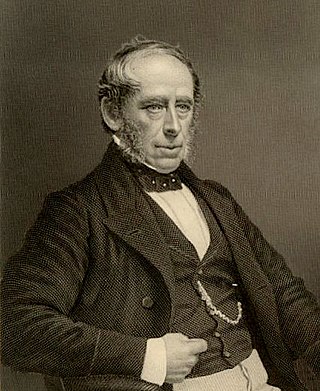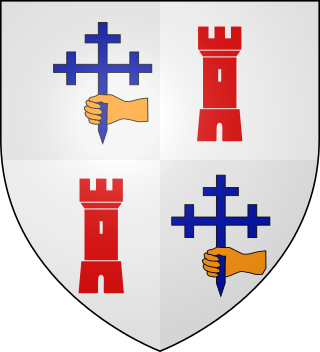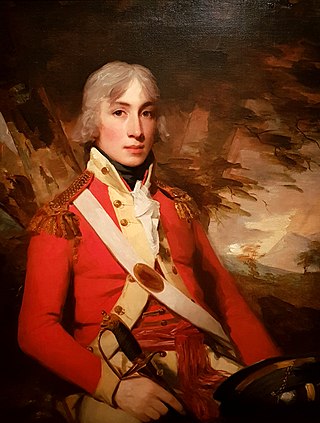
Earl of Dunmore is a title in the Peerage of Scotland.

Lord Napier, of Merchistoun, is a title in the Peerage of Scotland. It was created in 1627 for Sir Archibald Napier, 1st Baronet. Earlier that year, he already held the Napier Baronetcy, of Merchistoun in the County of Midlothian, created in the Baronetage of Nova Scotia. The titles remained united until 1683, when the Baronetcy became dormant. It was revived in the early 19th century and is now held by another branch of the Napier family. Between 1683 and 1686, the Lords of Napier also held the Nicolson Baronetcy, of Carnock in the County of Stirling, and since 1725 the Scott Baronetcy, of Thirlestane in the County of Selkirk, both baronetcies created in the Baronetage of Nova Scotia. The latter is still held today. Additionally, the tenth Lord was created Baron Ettrick, of Ettrick in the County of Selkirk in the Peerage of the United Kingdom on 16 July 1872.

Earl of Cromartie is a title that has been created twice, both for members of the Mackenzie family. It was first created as Earl of Cromarty in the Peerage of Scotland in 1703 for Sir George Mackenzie, 2nd Baronet, but his titles were forfeited after the Jacobite rising of 1745. It was recreated in 1861 in the Peerage of the United Kingdom for Anne Sutherland-Leveson-Gower, Duchess of Sutherland. Since 1979, the Earl of Cromartie has been chief of Clan Mackenzie.

Baron Rodney, of Rodney Stoke in the County of Somerset, is a title in the Peerage of Great Britain. It was created in 1782 for the naval commander Sir George Brydges Rodney, 1st Baronet. He had previously been created a Baronet, of Alresford in the County of Southampton, in the Baronetage of Great Britain on 22 January 1764. His son, the second Baron, represented Northampton in Parliament. He was succeeded by his eldest son, the third Baron. He served as Lord Lieutenant of Radnorshire. His younger brother, the fourth Baron, assumed by Royal licence the additional surname of Harley in 1804. On his death the titles passed to his younger brother, the fifth Baron. He was Rector of Elmley in Kent. He was succeeded by his nephew, the sixth Baron. He was the son of Captain the Hon. Robert Rodney, fourth son of the second Baron. The sixth Baron's great-grandson, the ninth Baron, was an active member of the House of Lords and served as a Delegate to the Council of Europe and the Western European Union. As of 2011 the titles are held by the latter's grandson, the eleventh Baron, who succeeded in 2011.

Baron Macdonald, of Slate in the County of Antrim, is a title in the Peerage of Ireland. It was created in 1776 for Sir Alexander Macdonald, 9th Baronet, of Sleat. The Macdonald family of Sleat descends from Uisdean Macdonald, also known as Hugh of Sleat, or Hugh Macdonald, who was an illegitimate son of Alexander Macdonald, Earl of Ross. On 28 May 1625, his great-great-great-great-grandson Donald Gorm Og Macdonald was created a baronet, of Sleat in the Isle of Skye in the County of Inverness, in the Baronetage of Nova Scotia. The baronetcy was created with remainder to heirs male whatsoever and with a special clause of precedence which provided that it should have precedency over all former baronets.

Baron Hampton, of Hampton Lovett and of Westwood in the County of Worcester, is a title in the Peerage of the United Kingdom. It was created in 1874 for the Conservative politician Sir John Pakington, 1st Baronet.
Baron Mostyn, of Mostyn in the County of Flint, is a title in the Peerage of the United Kingdom.

There have been two baronetcies created for persons with the surname Arthur, both in the Baronetage of the United Kingdom. As of 2014 both creations are extant.
There have been two baronetcies created for persons with the surname Colquhoun ("Cohoon"), one in the Baronetage of Nova Scotia (1625) and one in the Baronetage of Great Britain (1786).
There have been four baronetcies created for persons with the surname Leslie, one in the Baronetage of Nova Scotia, one in the Baronetage of Ireland, one in the Baronetage of Great Britain and one in the Baronetage of the United Kingdom. Three of the creations are extant as of 2010.

The Workman-Macnaghten, later Macnaghten Baronetcy, of Bushmills House in the County of Antrim, is a title in the Baronetage of the United Kingdom. It was created on 16 July 1836 for Francis Workman-Macnaghten, a Judge of the Supreme Court of Madras between 1809 and 1815 and of Calcutta between 1815 and 1825. Born Francis Macnaghten, he assumed the additional surname of Workman in 1809. The fourth Baronet discontinued the use of the surname Workman. In 1887 he was created a Lord of Appeal in Ordinary as Baron Macnaghten, of Runkerry in the County of Antrim. Both the sixth and seventh Baronets were killed in the First World War. Also William Hay Macnaghten was created a Baronet on 1840, but the Baronetcy became extinct upon his murder.

There have been two baronetcies created for persons with the surname Maclean, one in the Baronetage of Nova Scotia and one in the Baronetage of the United Kingdom. Both creations are extant as of 2010.
There have been three baronetcies created for persons with the surname Bellingham, one in the Baronetage of England, one in the Baronetage of Ireland and one in the Baronetage of Great Britain. As of 2014 one creation is extant.

The Dyke Baronetcy, of Horeham in the County of Sussex, is a title in the Baronetage of England. It was created on 3 March 1677 for Thomas Dyke, Commissioner of Public Accounts and Member of Parliament for Sussex and East Grinstead. The 2nd Baronet married Anne Hart, daughter and heiress of Percival Hart. In 1836 the 5th Baronet unsuccessfully claimed the barony of Braye, of which peerage he was a co-heir through the Hart family. The 7th Baronet was a successful Conservative politician. Percyvall Hart Dyke (1872–1952), grandson of Reverend Thomas Hart Dyke, second son of the 5th Baronet, was a Colonel in the Indian Army. His son Trevor Hart Dyke was a Brigadier in the Queen's Royal Regiment. David Hart Dyke, son of Reverend Eric Hart Dyke, son of the aforementioned Colonel Percyvall Hart Dyke, is a retired Captain in the Royal Navy and commanded HMS Coventry during the Falklands War. His daughter Miranda Hart is a well known writer, comedian, and actress.

General John Alexander Paul Macgregor, born John Alexander Paul, was an officer in the Bengal Army.
Lieutenant-Colonel Sir John Macgregor Murray, 1st Baronet, born John Murray, was a Scottish army officer.

Major-General Alexander Murray Macgregor, born Alexander Murray, was a Scottish army officer in the British East India Company.

Major-General Sir Evan John Murray-Macgregor of Macgregor, 2nd Baronet, was a Scottish colonial administrator and senior British army officer.
Sir John Atholl Bannatyne Murray-Macgregor of Macgregor, 3rd Baronet was a Scottish baronet and colonial administrator, who served briefly as President of the British Virgin Islands in 1851.
Rear-Admiral Sir Malcolm Murray-Macgregor of Macgregor, 4th Baronet, JP was a Scottish baronet and senior Royal Navy officer.













